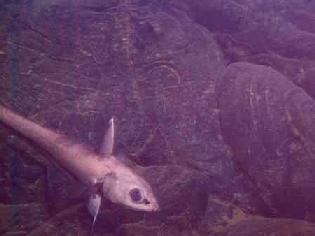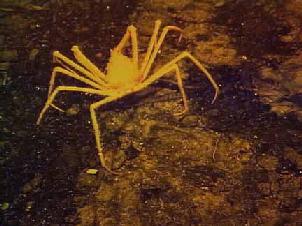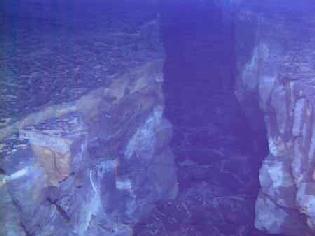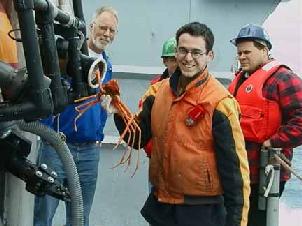WHAT'S NEW:
BACKGROUND:
Mission
Project Description
Cruise Plans:
Participants
Technology (ROV, ships, etc.)
Future Plans
Results:
1998 NeMO Cruise
Axial 1998 "Eruption"
Questions and Answers from scientists:
Or if clicking above does not work, send your message to:
nemo@pmel.noaa.gov
Include your name (or school/group), age and City in your message!
Put "NeMO question" as the subject.
(This is not limited to students!)
July 11, 1999
Questions from HMSC auditorium audience:
This is a more detailed answer to the questions posed on 7/10/99:
Q:Do they know what species of crab it was that was captured on dive
R498 and what is know about its life history? How big is it and what
was done with it?
A:
It is a known species: Macroregonia macrocheira.
This species was first described from two male specimens collected on the
Emperor Seamounts by Japanese trawlers. It is a majid crab related to
the king crab. Large males can reach a leg span of 1 meter.
We have studied the habits of this animal as it is one of the few normal
deep-sea animals that is able to tolerate the toxic sulphides at vents. The
males range widely in the deep-sea while we tend to find females and juveniles
clustered around the vents. They will pull tubeworms and snails from the
edges and move off to eat them. Males are agressive and often fight each
other - and even attack a submersible. We see females with incubating eggs
at the vents. I believe they are an important predator and a mechanism that
'transports' vent productivity into the surrounding deepsea.
July 10, 1999
Questions from the Wallace family:

(Christopher, age 7) Q: I would like to know how big the rat tail fish
(photo right) get at the vents and how they can live in these hot temperatures when
other fish can't.
A: Rattail fish can get up to at least three feet in length. Although
they are found near hydrothermal vents, they don't actually live in the
vent waters and are not specifically associated with vents. They are one
of the few deep water species of fish, and so it is common to see them at
these sites.
(Lauren, almost 5) Q: I want to learn more about
tube worms. I saw
baby tube worms at Botanical Beach. Do the baby worms come from egg
sacks?
A; What you probably say was an intertidal marine worm (polycheate) called
a serpulid. These worms reproduce by releasing eggs and sperm into the
water column. The sperm fertilizes the egg to create a "planktotrphic"
(living in the water column) larvae. The larvae will eventually settle on
the bottom and the worms will grow and secrete its tube. These
serpulids are very different from deep-sea tube worms which are actually
not polycheates, but vestimentiferans.
(Susan, "mom")Q: If oxygen destroys most of the bacteria you collect does that
eliminate the possibility of finding any viable pathogenic bacteria? Do
the precautions you take to ensure protection of the specimens also ensure
your protection in the event that they could survive in this environment?
A: First, Oxygen doesnt actually destroy most bacteria, it just inhibits
anaerobic bacteria from growing. Second, due to the selective pressure
and the nature of the extreme environments like hydrothermal vents,
pathogens are unable to grow. Bacteria that have a chemosynthetic
metabolism such as the ones that live at hydrothermal vents are not
pathogenic, though some have been found that produce antibiotics.
Questions from the HMSC auditorium audience:
 Q: Do they know what
species of crab it was that was captured on dive R498 and what is known
about its life history? How big is it and what was done with it?
Q: Do they know what
species of crab it was that was captured on dive R498 and what is known
about its life history? How big is it and what was done with it?
A: The crab captured on dive R488 (not 498) (photo left) is an unknown species. Like many vent
creatures, not much is known other then what is observed when it was
captured and studied while in the lab. This specimen was about 6 inches
(15 cm) in diameter. Upon reaching the lab the specimen had its 3rd left
walking leg removed and the rest was prepared for transfer to the
Chicago
Field Museum of Natural History for identification. The leg removed will
be analyzed for stable isotopes and lipid biomarkers. These will be used
to determine what part in the hydrothermal vent ecosytem food web it is
part of.
Q: How do they look for signatures of the food web in the animals tissues?
A: By knowing specifically what organisms feed on and are consumed
themselves, researchers hope to find basic compounds from one organism in
those that ate them. Researchers use certain isotopes (elements with
different atomic masses) as markers, and then try to identify them through
the pathway of the web. They use the fatty acids that make lipids in the
same manner. Samples tissue from organism is ground up and analyzed using
some extremely complex equipment. Based on the amounts of these specific
elements and building block compounds found, it is possible to theorize
which organism is the food for another.
Q: Are all hyperthermophiles classified as Archaea? Is the Moneran
classification used anymore?
A: Most of the hyperthermophilic microbes are classified as part of the
Archaea grouping. One group though is still part of the Bacteria group.
The Moneran classification is no longer used by most microbiologists. In
fact, the whole system of classification is undergoing some revamping, so
maybe in a few years the picture will be clearer.
Q: Recently, Canada established the
Endeavor segment of the Juan da Fuca
ridge as a
Marine Protected Area. How do those scientists on the cruise feel about
this?
A: The feeling on board is one of agreement with this tactic, in
principle. Concerns center on the constraints that will be applied to
this area with regards toward ongoing research at this location. This area
of the Juan de Fuca Ridge is one of the most vigorous and diverse
geological hydrothermal vent systems. It has yet to be determined what
regulations will be set in regards to research and sample collection. For
now they will wait and see what the next step is.
Q: Is there any chance that Axial Volcano will become a Marine Protected Area
like the Endeavor
Segment?
A:Axial volcano is in international water (it is outside the 200 mile
limit) there is no mechanism for such a move. The Endeavor segment falls
within Canada's 200 mile Exclusive Economic Zone, so they have the rights
to it.
July 9, 1999
Questions from HMSC auditorium audience:
1) Have any dna studies been done on the sea floor critters to see how much their dna has diverged from sea surface critters? That is, do we have any idea where they fit into the ancestry chain?
Comparison studies looking at the ancestry chain have not necessarily been done using DNA but rather from fossils. It appears that most seafloor critters are newer than sea surface critters - that is that the modern sea fauna came from above.
2) Are any precious metals turning up in the rocks?
(Also see information in the
7/5/99 Perspective)
The 1998 lava flow is made of a volcanic rock called basalt. Generally,
there are no precious metals in basalt, although one of the minerals in
basalt is olivine, which is called peridot when it is gem-quality. This
is rare however (there is no peridot at Axial volcano). On the other
hand, there are precious metals in the sulfide chimneys that form at
hydrothermal vents. When seawater circulates down into the ocean crust
and gets heated up in volcanic areas, the heated water leaches out many
elements from the rocks and these get concentrated in the vent fluids.
Where the hot water exits the seafloor and mixes with the cold bottom
water, it immediately cools and precipitates minerals which build a
sulfide chimney around the vent orifice. Elements such as zinc, copper,
platinum, silver, and gold can be concentrated in hydrothermal sulfide
deposits. It is unlikely that it will ever be economical to mine
hydrothermal deposits on the seafloor, but there are many mineral deposits
presently mined on land that were formed long ago on the seafloor. In
fact, the study of the active ore-forming processes at hydrothermal vents
has helped geologist better understand how these ancient deposits
originally formed.
July 6, 1999
Q: Do you know if the fissure went together?
Kelly Chadwick, age 6
(Kelly's father,
Bill, is aboard the Thompson).
 A: Hi Kelly! The fissure
that opened up and erupted the lava flow last year (photo right) has solidified
lava in it now, so it cannot close back up. In fact, this is what seafloor
spreading is all about - the two tectonic plates are being slowly pulled
apart, periodically a crack opens along the plate boundary, magma fills
the crack (forming a dike), and the plates are then a little further apart
than they were to start with. Judging from what we saw on the seafloor,
the Pacific and Juan de Fuca tectonic plates spread apart by about
1.5 meters during the 1998 eruption. On the other hand, the fissure
we saw on the seafloor does come together at either end - that is, it
is open in the middle and pinches shut at either end.
A: Hi Kelly! The fissure
that opened up and erupted the lava flow last year (photo right) has solidified
lava in it now, so it cannot close back up. In fact, this is what seafloor
spreading is all about - the two tectonic plates are being slowly pulled
apart, periodically a crack opens along the plate boundary, magma fills
the crack (forming a dike), and the plates are then a little further apart
than they were to start with. Judging from what we saw on the seafloor,
the Pacific and Juan de Fuca tectonic plates spread apart by about
1.5 meters during the 1998 eruption. On the other hand, the fissure
we saw on the seafloor does come together at either end - that is, it
is open in the middle and pinches shut at either end.
Thanks for the question!
Questions from the HMSC Public Wing audience:
Q:When was Axial Volcano discovered and how did it get its
name?
A:Axial was first discovered in the last 1970s during the first intensive
investigation by the University of Washington. The first detailed map of
the summit caldera (the site of the NeMO program) was made by the NOAA
ship Surveyor in 1981 using the then new Sea Beam mapping system which,
for the first time,. provided oceanographers with the capability to map
the seafloor in continuous swaths. Axial Volcano was named for its
position on the
axis of the Juan de Fuca ridge.
Q:What biotechnology applications are foreseen for Hydrothermal vent
bacterium?
A:Several examples of present products derived from these unique
microbes
in the biotechnology industry include: (1) proteases (used in things like
laundry detergents), (2) high temperature enzymes (such as
taq-polymerase, an enzyme used in PCR - a laboratory technique that makes
copies of DNA), and (3) one of the most important - the use of secondary
metabolites for drug discovery (for example antibiotics).
Q:If bacteria are so hard to culture, why dont they die as they are
brought up from the vent to the surface?
A: High temperature bacteria are simply very tough and resilient bugs.
Traveling up from the bottom does not seem to phase them. Getting them to
grow in a laboratory setting, however is the tricky part and requires the
right combination of temperature and nutrient base.
July 2, 1999
Questions from the HMSC Public Wing audience:
How is vent fauna nourished with
oxygen?
Vent fauna collect their oxygen just as other organism do in the
sea, they absorb if from the sea water. Oxygen dissolves into the sea
water at the surface of the water where it comes in contact with the
atmosphere.
Do hyperthermophiles (microbes that live above 100 degrees
Celsius) from the subsurface biosphere need oxygen?
Hyperthermophiles do not use oxygen. They are referred to as
anaerobes which means "without oxygen". Vent fluid must mix with deep sea
water in order to pick up dissolved oxygen
Are vent communities related to life of the photic zone?
Vent communities are unique on to themselves. Their systems do
not relate to those that use the sun as an energy source for making
organic nutrients through photosynthesis. It is still up for discussion
as to vents being a possible origin of life.
Lots more work needs to be done before this will be widely accepted.
June 25, 1999
Question:
Dear Maia and Christian (and Jean and others):
If these crabs are so rare, how did you manage to catch two and how many are left? What will you do with them?
Fondly from Arielle Katherine Garrett
Age 8, ST. Margaret's School, Victoria
P.S. What is this thing about this abducted honey bear causing problems
P.P.S. I have a happy mother after reading about the camera!!
(
Verena on board the Thompson is Arielle's mother)
Answer:
Hi Arielle!
 It was great to
get your questions! Unfortunately, there is no way for us to actually
know how many crabs are left in the area, so the only answer we can give
to your first question is "one less". But it is an important question
because scientists (and others) need to be aware of the effects they can
have on the area they study. At vents, many scientists want to do many
things and sometimes sampling can interfere with other studies. So we
need to try to minimize the impact we have and keep nature as natural
as can be. One of the ways we can do this is to be careful with what we
take and or make some vent areas places that we all agree to leave untouched.
As for the unfortunate crab we caught (left), we hope that it will help
us understand a bit more about how the food chain works down there...
More precisely, Christian (photo with crab) will analyse it in his laboratory
back in Montreal, Canada, to try and find out what this creature eats.
In any case, don't worry about the crabs. This one will be enough to help
us answer many questions and we won`t need to catch anymore so the ones
still down there can rest easy.
It was great to
get your questions! Unfortunately, there is no way for us to actually
know how many crabs are left in the area, so the only answer we can give
to your first question is "one less". But it is an important question
because scientists (and others) need to be aware of the effects they can
have on the area they study. At vents, many scientists want to do many
things and sometimes sampling can interfere with other studies. So we
need to try to minimize the impact we have and keep nature as natural
as can be. One of the ways we can do this is to be careful with what we
take and or make some vent areas places that we all agree to leave untouched.
As for the unfortunate crab we caught (left), we hope that it will help
us understand a bit more about how the food chain works down there...
More precisely, Christian (photo with crab) will analyse it in his laboratory
back in Montreal, Canada, to try and find out what this creature eats.
In any case, don't worry about the crabs. This one will be enough to help
us answer many questions and we won`t need to catch anymore so the ones
still down there can rest easy.
The Honey Bear is another matter however. We have been having some problems with our equipment and with ROPOS and we have learned (from one of the crew) that the cause of all our bad luck is a little plastic bear that usually holds honey. We have taken care of this situation and expect our luck to turn around. Sailors can be very superstitious and so can scientists!
Maia and Christian
For more information:
Credits/Contacts
oar.pmel.vents.webmaster@noaa.gov